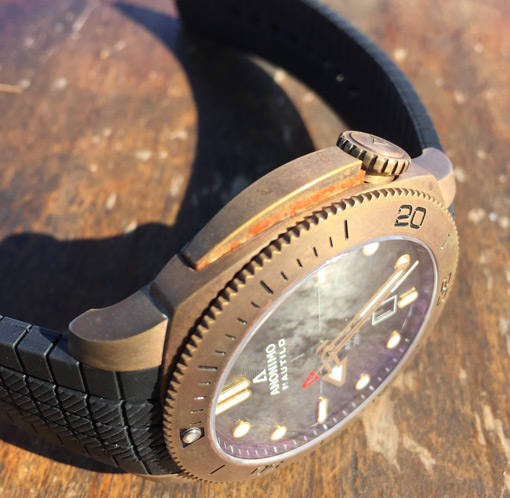Bell & Ross and Panerai are just two of the watch brands to have released a bronze watch recently. The metal offers a number of advantages: it is cheaper than gold; it’s original and relatively underused as yet; it is reminiscent of vintage chandlery and boat fittings, which is a good match with the dive watches that generally use it; it evolves over time, its appearance changing as its unique patina develops; and finally, the accelerated aging process gives each watch a highly individual character.
Bronze or bronzes?
Technically, bronze’s time-sensitivity is due to the presence of cooper within the bronze alloy. Bronze isn’t a pure metal: it’s an alloy of copper and tin. And, to get even more technical, bronze is not a single alloy but a potentially infinite variety of alloys, depending on the proportion of different elements they contain. Usually, bronze is made up of over 60% copper, but it also has varying amounts of tin, aluminium, lead, beryllium, manganese and tungsten, in addition to silicon and phosphorus.
Within this recipe, copper, being the most prevalent element, changes the most and has the greatest impact on the appearance of the watch. Its main oxidising agent is salt – present on the surface of the skin or, in the case of diving watches, the sea. The Anonimo Nautilo, built for exploring the ocean depths, falls in the latter category.
Sized for the deep
This watch has a diameter of well over 45 mm, which offers the advantage of perfect legibility. Its uncluttered face makes it relatively unostentatious, but it has all the diving essentials: unidirectional bezel, generous luminescent indices for visibility in the murky ocean, rubber strap, solid screw-down caseback and water resistance to 200 metres. The watch is driven by an automatic Sellita SW200-1 movement.
In addition to noting these technical specifications, our team tested the oxidisation process of the bronze case. Over the course of 15 days, the watch was subjected to the salt spray and sandy shores of the Indian Ocean. With high iodine levels, and humidity over 65%, the Nautilus’s case was given quite a thorough workout.

15 days in Bali
Over 15 days of continuous wear, without rinsing, the watch very swiftly showed signs of accelerated aging. In less than four days the bezel started to lose its shine, and then began to tarnish. The case band soon followed suit. Exposed to ocean spray, the case also started to show some corrosion, which attacked the bronze and produced some blackening.
Unsurprisingly, it was in the Nautilo’s tightest corners, where the iodine tended to lodge, that the corrosion was the most pronounced. There was also an atypical reaction on the crown protection, which protrudes from the case between 1 and 4 o’clock. Here, the Nautilo didn’t acquire the verdigris we expect from bronze; it actually started to rust. The effect was surprising but not unwelcome. It gives the watch the vintage vibe and authentic patina of a seasoned travel companion, although it will be important to ensure that the rust doesn’t permanently damage the structure of the watch and jeopardise its water-tightness. This is something that, under normal conditions, would have taken months or even years of testing to check. However, even if bronze takes a lifetime to develop its patina, the Swiss watch industry is such that you can always find an excuse to have two or three, so that you can measure the comparative effects of time!







